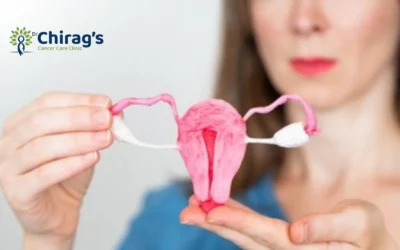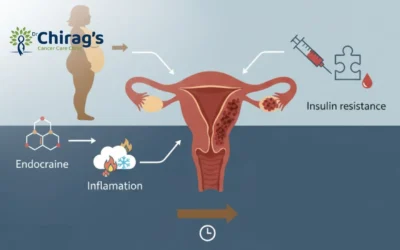
When we perform a pelvic ultrasound, sometimes we notice a collection of fluid inside the uterine lining—what we medically call the endometrial cavity. This finding is termed a Sonographic Endometrial Fluid Collection (EFC).
Your immediate concern, “Does this mean cancer?” is completely valid and the first thing on every patient’s mind. Let me reassure you: no, this fluid does not automatically mean cancer. In the vast majority of cases, it’s a benign issue.
However, because it can be an early warning sign of something serious, particularly Endometrial Cancer specialist in pune or elsewhere, we must treat it with respect and investigate thoroughly.
What are the common, non-cancerous causes of this fluid?
In my practice here in Pune, the most frequent benign cause is often something called cervical stenosis, particularly in post-menopausal women.
Think of your cervix, the neck of the uterus, as a narrow drainpipe. After menopause, a combination of natural atrophy and scarring can cause this drain to narrow or even close (stenosis).
When this happens, the normal, clear, watery secretions of the uterus—a condition called Hydrometra—cannot escape, and they collect inside the cavity.
Similarly, a minor blockage can trap old menstrual blood, leading to Hematometra.
Other common culprits include benign, fleshy growths called uterine polyps or small tumors called fibroids that slightly obstruct the flow or cause local fluid secretion.
Very rarely, it can be Pyometra, an accumulation of pus, which indicates an infection, but this is usually accompanied by fever and significant pain.
When does the fluid collection indicate a higher risk of Endometrial Cancer?
The alarm bells, which necessitate immediate, deep investigation, ring when we see the fluid collection in a post-menopausal patient who is also experiencing abnormal symptoms or whose scan shows concerning characteristics.
The critical clue we look for is the thickness and nature of the tissue surrounding the fluid. If the endometrial lining is significantly thickened (generally over 3 to 5 millimeters) or looks irregular or complex (what we call ‘echogenic’ or cloudy fluid, suggesting blood or pus), the probability of endometrial hyperplasia or cancer increases.
In essence, the fluid acts as a magnifying glass, drawing our attention to the surrounding tissue, and it’s this surrounding tissue—the “doughnut,” not just the “hole”—that we are primarily worried about.
If you have had any abnormal vaginal discharge or post-menopausal bleeding (PMB), even light spotting, combined with this fluid, we move forward with definitive diagnostic tests immediately.
What diagnostic tests will you perform to find the definitive cause?
To solve this medical puzzle, we follow a clear, step-by-step protocol. The first step is the Transvaginal Ultrasound (TVUS), which you’ve likely already had, to visualize the fluid and measure the endometrial thickness. Next, to get a clearer picture, we may perform a Saline Infusion Sonography (SIS) or Sonohysterography.
This involves gently introducing a small amount of sterile saline water into the uterine cavity during an ultrasound to distend it and clearly outline the lining, making polyps or masses visible.
Before discussing the next steps, it’s important to understand that timely diagnosis plays a crucial role in outcomes. You can read more about this in our detailed section on Endometrial Cancer Survival Rate, which explains how early detection and appropriate treatment significantly improve long-term recovery.
The gold standard for a definitive diagnosis—the only way to truly rule out or confirm cancer—is an Endometrial Biopsy, often performed with a device called a Pipelle in the outpatient setting.
If the cervix is too narrow or the biopsy is inconclusive, a surgical procedure called a D&C (Dilatation and Curettage), often coupled with a camera-guided Hysteroscopy, is performed under light anesthesia to get a full tissue sample for histopathology (lab analysis). This confirms the cell type and if any cancer is present.
If it is cancer, what are the next steps for staging and treatment?
Should the biopsy confirm an endometrial or uterine malignancy, please know that endometrial cancer is highly treatable, especially when caught early.
The primary and most curative step is always surgical, typically a Hysterectomy (removal of the uterus and cervix), often combined with the removal of the fallopian tubes and ovaries, and a careful assessment of the lymph nodes.
As Doctor and a specialist in advanced surgical techniques, I emphasize minimally invasive approaches, such as laparoscopic or robotic surgery. This means smaller incisions, less pain, shorter hospital stays, and quicker recovery, getting you back to your life faster.
Based on the cancer’s type and stage (how far it has spread, according to the FIGO system), we then decide if you need any additional treatment (adjuvant therapy), such as radiation, chemotherapy, or hormone therapy, to ensure the best possible long-term outcome.
How will you support me emotionally and help me navigate recovery?
Cancer care is about more than just surgery; it’s about holistic recovery. The emotional and mental toll of a cancer diagnosis or even the uncertainty before a diagnosis is immense.
My commitment, and that of my entire team at my clinic, is to ensure open, compassionate communication at every stage.
We practice shared decision-making, meaning we discuss all options together, respecting your values and concerns. Recovery involves a structured plan for pain management, wound care, and gradually returning to your physical activities.
More importantly, we connect you with robust support systems, including patient counselors and local support groups, leveraging the strong network of the Best Cancer Care Clinic in Pune to help you process the journey and focus on healing.
What can I do for proactive and preventive awareness in the future?
The most important takeaway is this: never ignore abnormal bleeding, especially after menopause. It is the single clearest red flag for uterine cancer. If you experience PMB, even a drop of spotting, consult a specialist immediately.
Furthermore, managing lifestyle risk factors is vital. Given the connection between obesity, high estrogen levels, and endometrial cancer risk, maintaining a healthy weight, controlling blood pressure, and managing diabetes are all powerful preventive actions.
Regular annual health checkups, adherence to surveillance protocols, and a focus on overall well-being are the best shields you have. Knowledge is power, and being aware of your body’s signals allows us to intervene early when treatment is most effective.
Frequently Asked Questions (FAQs)
1. Is it possible to have fluid in the uterus and a thin endometrial lining?
Yes, absolutely. A thin endometrial lining (typically $\le 3\text{ mm}$ to $5\text{ mm}$ post-menopause) with clear fluid is often a classic sign of benign cervical stenosis (Hydrometra/Hematometra). In this scenario, the risk of cancer is very low, and the fluid itself is usually the result of the blockage, not a tumor.
2. Can I postpone the D&C if I am asymptomatic (no bleeding)?
If you are post-menopausal and the fluid is clear with a very thin endometrial lining (≤ 3 mm), some clinicians may opt for a period of surveillance. However, if the fluid is echogenic (cloudy) or the lining is thicker, or if you have any risk factors, a definitive tissue sample is still highly recommended to rule out subtle, non-bleeding malignancies.
3. What is the difference between fluid in the endometrial cavity and fluid in the pelvis?
Fluid in the endometrial cavity is contained inside the uterus and relates specifically to uterine or cervical issues. Fluid in the pelvis (like the Cul-de-Sac/Pouch of Douglas) is outside the uterus and can be due to ovulation, ruptured cysts, infection (PID), or more advanced cancers of the ovary or other organs. They are two distinct medical findings.
4. Can taking Tamoxifen cause endometrial fluid or thickening?
Yes, Tamoxifen, a medication often used for breast cancer, is known to stimulate the uterine lining, which can lead to benign endometrial thickening, polyps, and sometimes fluid collection. If you are taking Tamoxifen, your gynecological surveillance needs to be more stringent, and a thickness cutoff of $5\text{ mm}$ is often used as a more cautious threshold for biopsy.
5. How long does it take to get the biopsy results back?
Typically, the final histopathology report from the endometrial biopsy or D&C takes between 5 to 7 working days. Once the report is ready, your doctor will schedule a detailed consultation to discuss the findings and determine the next steps, ensuring there is no delay in starting treatment if necessary.
Conclusion
Fluid in the endometrial cavity is a finding that warrants careful, expert evaluation, but it is not a reason for immediate panic. By correlating the ultrasound finding with your menopausal status and symptoms, we can quickly determine the cause.
Whether it is a simple blockage or a complex malignancy, advanced surgical and oncological care is readily available. My experience as a specialist onco-surgeon is dedicated to providing you with the most precise diagnosis and the most compassionate, cutting-edge treatment right here in Pune.
If you have received this finding on a scan or are experiencing abnormal symptoms, do not delay. Your peace of mind and health are paramount. I encourage you to seek an expert opinion today.
If you have any further queries, please write to us.
Latest Blogs
Does endometrial cancer cause postmenopausal bleeding?
Postmenopausal bleeding is never normal and can be an early sign of endometrial cancer. Learn causes, risks, tests, and treatment guidance from a leading cancer specialist in Pune.
Is Endometrial Cancer The Same As Uterine Cancer?
Endometrial cancer is the most common type of uterine cancer. Learn symptoms, diagnosis, stages, and treatment options from Dr. Chirag Bhirud.
Obesity & Endometrial Cancer: What’s the Connection?
Learn how obesity raises endometrial cancer risk. Dr. Chirag Bhirud, Onco Surgeon in Pune, explains causes, symptoms, and preventive care in simple terms.






